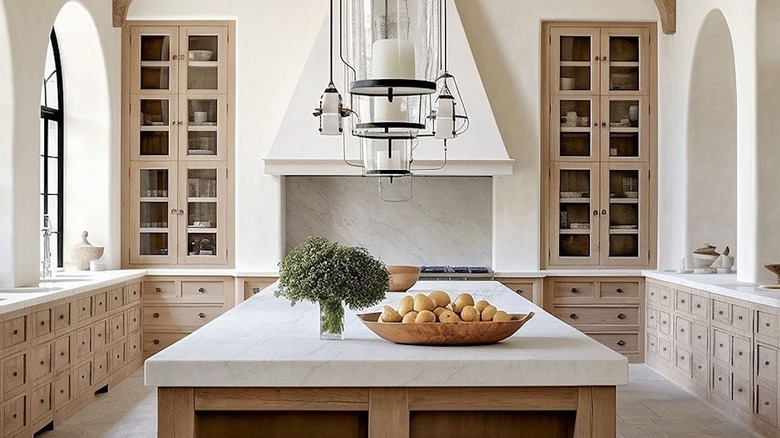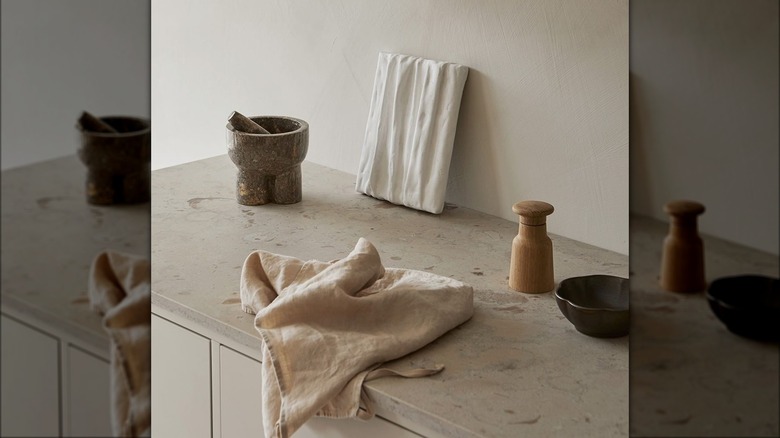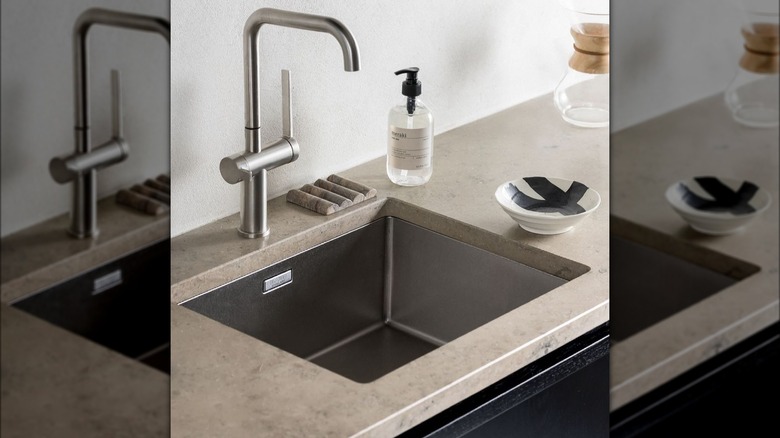How Much It Might Cost To Install Limestone Countertops In Your Home
When most folks think of luxe countertops, they think of marble. After all, it's the most expensive material you can choose (costing as much as $250 or more per square foot), but there are plenty of other ways to achieve a similar aesthetic at a fraction of the price. Indeed, we can think of 15 different types of countertops you should consider before your next kitchen remodel, including granite, quartz — and limestone.
Limestone is a sedimentary rock with a granular texture that, interestingly, is often caused by tiny pieces of fossilized animal shells. Durable and strong, it's a popular building material, making it a good contender for countertops. However, because of its longevity, it is more expensive than granite, which usually costs between $40 and $100 per square foot, and quartz, which averages up to $149 per square foot. Limestone, on the other hand, starts at $70 a square foot and can go up to $200 a square foot, depending on factors like how many cutouts you'll need and the rarity of the color. Limestone slabs are mostly available in neutral colors such as pure white, off-white, and beige. Sometimes, though, shades of gray, brown, and yellow can be found, and these will be more expensive.
You can expect the finished price (with installation) to average around $2,200, but it can run as much as $5,500. Because it's a substantial investment, there are some things you'll need to consider before saying yes to limestone.
Are limestone countertops right for you?
When it comes to ranking the most durable kitchen countertops, limestone tops the list of possible materials. From the ancient pyramids of Giza in Egypt to Washington, D.C.'s Lincoln Memorial, some of the greatest structures on earth have been built using limestone, proving this material can withstand the test of time. Similarly, a limestone countertop can last you a lifetime, which helps justify its initial price tag — not to mention it's a great material for kitchens because of its high heat resistance. Plus, it can increase your home's resale value, as it's considered a luxury finish.
For all of the pros, though, there are also some cons. Limestone is more porous than quartz and granite, so it will require greater care and attention. It scratches easily, so you'll always need to be wary of sharp objects and use a cutting board. Limestone is also quick to stain, so accidental spills will need to be cleaned up immediately, especially if they're dark-colored, like red wine, black tea, and coffee. Lastly, limestone's composition makes it highly reactive to anything acidic, which means most everyday cleaners will need to be avoided, as they can dissolve the material.
How to care for limestone countertops
When it comes to limestone, maintenance is key, as it's one of the countertop materials that is hardest to keep clean. You'll need to be vigilant of spills, wiping them away immediately, while also cleaning the whole countertop regularly with a soft cloth (sponges can be too abrasive and scratch the surface) and products created specifically for limestone. If, despite your best efforts, a stain does occur, mix baking soda and hydrogen peroxide into a thick paste, lather it on the problem area, cover it with plastic wrap, and let it sit. After 24 hours, wipe the surface clean and reseal it. You'll need to do this at least once a year.
Because limestone is so porous, sealing it annually is a step that can't be skipped. Sealing will keep your countertops looking new for decades by ensuring discoloration doesn't occur. Luckily, it's something you can do yourself with a store-bought sealer. Simply follow the instructions on the label. If you're not quite sure if it's time to reseal, you can test the surface by pouring about three inches of water onto the countertop and letting it sit for 30 minutes. If dark spots appear, the tiny pores in your countertop are allowing the water to pass through the stone, indicating it's time to reseal.


